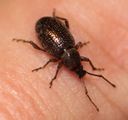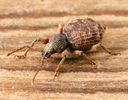Otiorhynchus
Otiorhynchus
Classification
- Phylum: Arthropoda
- Subphylum: Hexapoda
- Class: Insecta
- Order: Coleoptera
- Suborder: Polyphaga
- Superfamily: Curculionoidea
- Family: Curculionidae
- Subfamily: Entiminae
- Tribe: Otiorhynchini
- Genus: Otiorhynchus
Pronunciation
How to pronounce Otiorhynchus: //ˌəʊtiəˈrɪŋkəs//
These audio files are automatically generated. While they are not always 100% accurate, they are a good starting point.
Images






Summary
Otiorhynchus is a large genus of flightless weevils with significant agricultural impact due to their herbivorous larvae and adults. Native to the Palaearctic, some species are widespread adventives in North America, often found in gardens and homes.
Physical Characteristics
4-11 mm snout stout, squarish, widened toward tip; pronotum roundish with pebbled or bumpy surface; elytra color varies from light yellowish-brown to black, surface variously sculptured, rarely smooth.
Identification Tips
Adults are flightless with fused elytra; look for the pronounced snout and bumpy pronotum.
Habitat
Commonly found on or near host plants, in gardens, and sometimes indoors during colder months.
Distribution
Native to the Palearctic region, adventive and widely established in North America, extending north to Alaska and the Northwest Territories.
Diet
Polyphagous herbivores; larvae feed on plant roots and adults feed on plant foliage at night.
Life Cycle
Species may have diploid and bisexual races as well as parthenogenetic forms; life cycle involves both larval and adult stages feeding on host plants.
Reproduction
Includes both diploid and parthenogenetic species; specific reproductive behaviors vary among species.
Ecosystem Role
Important pests in ecosystems as they affect plant health and growth through their herbivorous feeding habits.
Economic Impact
Many species, including O. sulcatus and O. ovatus, are significant pests detrimental to agriculture and horticulture.
Collecting Methods
- Sampling in gardens and areas near host plants
- Using pitfall traps
Preservation Methods
- Ethanol preservation
- Drying and pinning for display
Evolution
Some species studied for evolution of parthenogenesis; exhibits diversity with over 1,500 species and 105 subgenera.
Similar Taxa
Misconceptions
Often misspelled as 'Otiorrhynchus' instead of 'Otiorhynchus'; perceived as only major agricultural pests without recognizing ecological roles.
Tags
- weevils
- Otiorhynchus
- pests
- herbivores
- Coleoptera